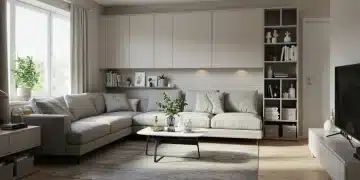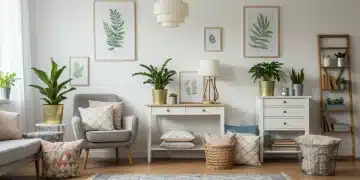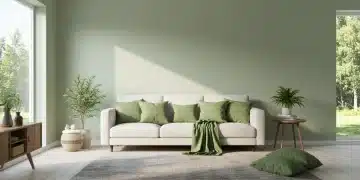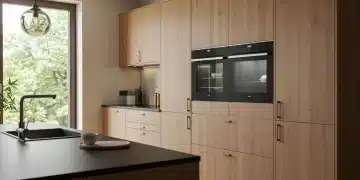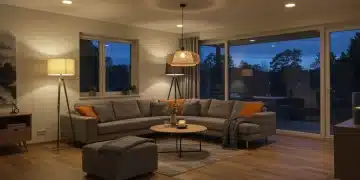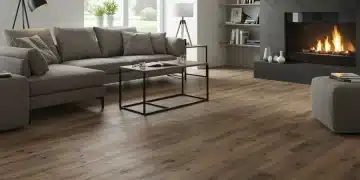Top 5 Family-Friendly Home Decor Trends to Dominate 2025 in the US
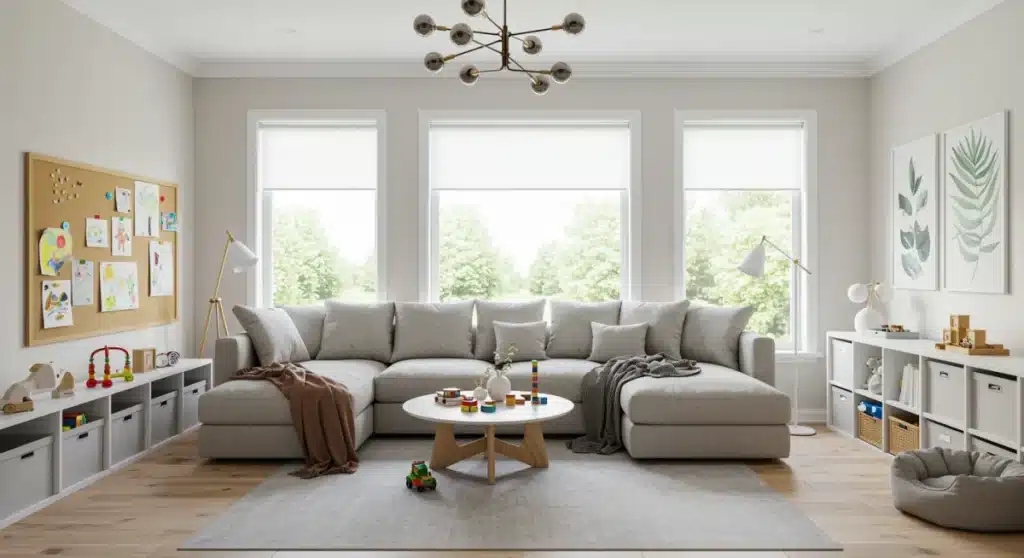
Advertisement
The top 5 family-friendly home decor trends for 2025 in the US will focus on creating adaptable, safe, and stylish environments that cater to the evolving needs of modern families, blending aesthetic appeal with practical functionality.
Are you ready to transform your living space into a haven that perfectly balances style with the dynamic needs of your loved ones?
The year 2025 is set to usher in exciting developments in home aesthetics, particularly focusing on
family-friendly home decor trends across the US.
These trends promise to make your home not only beautiful but also functional, safe, and adaptable for every member, from toddlers to teenagers and beyond.
Let’s explore what’s on the horizon for creating harmonious family environments.
Advertisement
The Rise of Multi-Functional Spaces and Adaptable Furniture
In 2025, the concept of a single-purpose room is gradually fading, replaced by innovative designs that maximize utility and flexibility.
Families in the US are increasingly seeking smarter ways to utilize their living areas, making every square foot count.
This trend is about creating environments that can effortlessly transition from a play area to a study zone or a guest room, often within the same space.
Adaptable furniture is at the heart of this movement. Think pieces that can be reconfigured, folded, or expanded to serve various functions.
This approach not only saves space but also encourages creativity and efficiency in family life.
It’s about having furniture that grows with your family and adapts to their changing needs.
Advertisement
Modular Seating Solutions
Modular sofas and sectionals are becoming indispensable. These versatile pieces can be rearranged to accommodate different activities,
from a cozy family movie night to a large gathering of friends. Their flexibility means you can easily adjust your living room layout
without investing in entirely new furniture.
The emphasis is on comfort, durability, and ease of cleaning, crucial for busy households.
- Customizable Layouts: Easily reconfigure for entertaining or relaxation.
- Durable Fabrics: Stain-resistant and washable materials are a must.
- Hidden Storage: Many modular units now include integrated storage compartments.
Transformable Tables and Desks
Dining tables that extend, coffee tables that lift to become workstations, and desks that fold away are perfect examples of this trend.
These items allow a single area to serve multiple purposes throughout the day.
This is particularly beneficial for families in urban settings or smaller homes where space is a premium.
The goal is to reduce clutter and enhance usability.
The beauty of multi-functional spaces lies in their ability to evolve. A child’s bedroom might feature a bed with integrated storage and a pull-out desk,
ensuring it can serve as a sleeping area, study zone, and play space as they grow.
This smart design prevents the need for frequent furniture replacements, making it a sustainable and economical choice for families.
Ultimately, the drive towards multi-functional spaces and adaptable furniture reflects a broader desire for simplicity and efficiency in the home.
It’s about creating a living environment that supports the diverse activities of family members without compromising on style or comfort.
Embracing Biophilic Design for Family Well-being
Biophilic design, the integration of nature into interior spaces, is gaining significant traction, especially in family homes.
This trend recognizes the profound impact that natural elements can have on mental and physical well-being,
reducing stress, improving cognitive function, and fostering a sense of calm.
For families, this means creating environments that feel more connected to the outdoors, even within urban settings.
In 2025, expect to see an increased emphasis on natural light, indoor plants, and materials that evoke the natural world.
It’s about bringing the restorative power of nature indoors to create healthier and more harmonious living spaces for everyone.
Natural Light Maximization
Optimizing natural light is a cornerstone of biophilic design. Large windows, skylights, and strategic placement of mirrors
are used to flood interiors with daylight, reducing reliance on artificial lighting.
This not only improves mood but also has practical benefits, such as lower energy consumption.
- Sheer Curtains: Allow light in while maintaining privacy.
- Light-Colored Walls: Reflect natural light throughout the room.
- Open Layouts: Minimize obstructions to light flow.
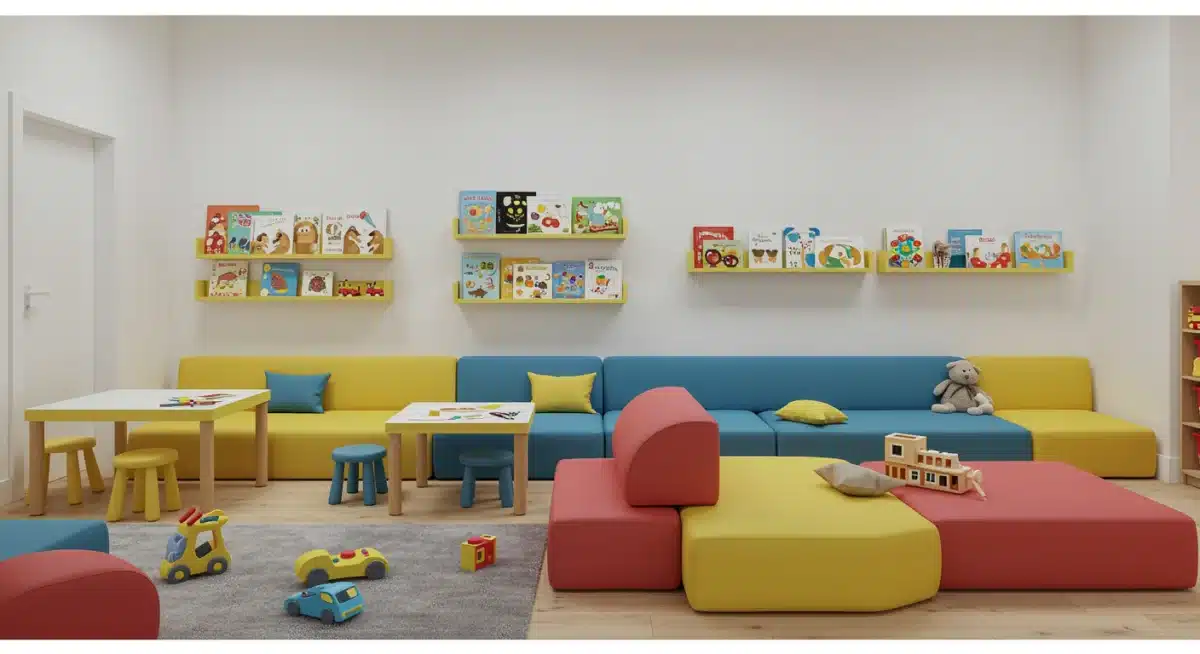
Incorporating Indoor Greenery
Houseplants are more than just decorative accents; they are vital components of a biophilic home.
They purify the air, add vibrant color, and create a soothing atmosphere.
For families, choosing low-maintenance and non-toxic plants is key, ensuring safety for children and pets.
Beyond plants, biophilic design also involves using natural materials like wood, stone, and rattan.
These materials introduce texture and warmth, grounding the space and creating a sense of authenticity.
Colors inspired by nature, such as earthy tones, soft greens, and blues, will be prominent, fostering a calm and inviting ambiance.
The goal is to create a sanctuary where families can relax, recharge, and feel connected to the world outside.
This trend is a holistic approach to home decor, aiming to enhance the overall well-being of family members by consciously integrating elements that mimic natural environments.
It’s about creating a home that breathes and thrives, just like the family within it.
Smart Storage Solutions and Organization Systems
Clutter is a common challenge in family homes, but in 2025, innovative storage solutions are set to transform how families organize their spaces.
This trend goes beyond simple shelves and cabinets, focusing on integrated, intelligent systems that make tidying up effortless and efficient.
The aim is to create serene and functional environments where everything has its place, reducing stress and promoting harmony.
Effective organization is crucial for busy families, saving time and mental energy.
This trend highlights custom-built solutions and multi-purpose furniture pieces designed to conceal clutter while enhancing the aesthetic appeal of a room.
Integrated Storage Furniture
Furniture with built-in storage is a game-changer for family homes.
Beds with drawers underneath, ottomans that open up for blankets, and coffee tables with hidden compartments are just a few examples.
These pieces serve dual purposes, offering functionality without sacrificing style.
- Window Seats with Storage: Perfect for books and toys in a cozy nook.
- Media Consoles: Designed to hide wires and electronic devices.
- Benches with Baskets: Ideal for entryways to store shoes and bags.
Custom Built-Ins and Wall Systems
For a truly seamless and organized look, custom built-ins are becoming increasingly popular.
These systems are designed to fit specific spaces, maximizing storage potential from floor to ceiling.
They can be tailored to store anything from children’s toys and craft supplies to books and media equipment,
creating a streamlined and sophisticated appearance.
Wall-mounted shelving and pegboards also offer flexible storage solutions, especially in playrooms or home offices.
They keep items off the floor, making cleaning easier and preventing tripping hazards.
The key is to design systems that are accessible for all family members, encouraging everyone to participate in maintaining an organized home.
By embracing smart storage solutions, families can create homes that are not only beautiful but also remarkably functional and easy to maintain.
It’s about making organization an integral part of the decor, rather than an afterthought.
Sustainable and Eco-Conscious Decor Choices
As environmental awareness grows, sustainable and eco-conscious decor is becoming a dominant trend in family homes across the US.
Families are increasingly seeking products that are not only aesthetically pleasing but also ethically produced and environmentally friendly.
This movement is driven by a desire to create healthier living environments and reduce ecological footprints.
In 2025, expect to see a greater demand for furniture and decor made from recycled, reclaimed, or sustainably sourced materials.
It’s about making choices that benefit both your family and the planet.
Recycled and Reclaimed Materials
Furniture crafted from recycled plastic, reclaimed wood, or upcycled materials offers a unique charm and significantly reduces waste.
These pieces often tell a story and add character to a room, making them a focal point of conscious design.
Families appreciate the durability and individuality that these materials bring to their homes.
- Reclaimed Wood Tables: Add rustic charm and sustainability.
- Recycled Glass Decor: Stylish and environmentally responsible.
- Upcycled Textiles: Introduce unique patterns and textures.
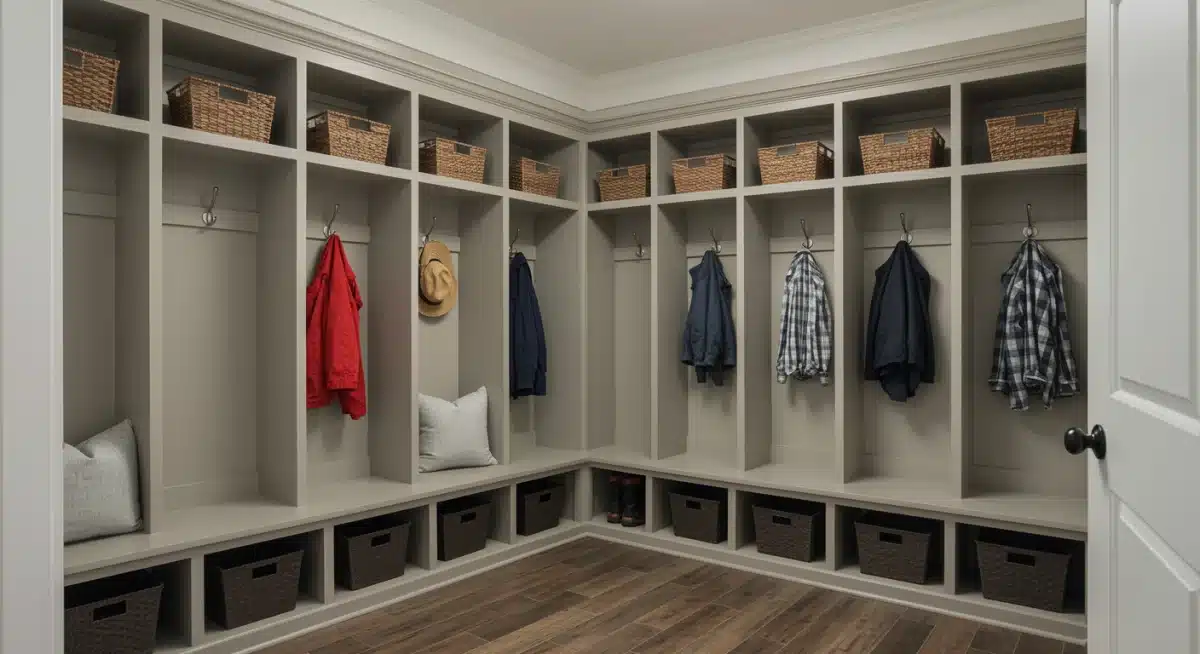
Non-Toxic and Low-VOC Finishes
The health of family members, particularly children, is a top priority.
This has led to a surge in demand for non-toxic paints, finishes, and fabrics.
Low-VOC (Volatile Organic Compound) products minimize harmful chemicals in the home, contributing to better indoor air quality.
It’s a critical consideration for creating a safe and healthy environment for growth and development.
Additionally, brands that prioritize fair trade practices and transparent supply chains will gain favor.
Consumers are becoming more discerning about where their products come from and how they are made.
This trend signifies a shift towards more thoughtful consumption, where design choices reflect personal values and a commitment to a better future.
Choosing sustainable decor is not just a trend; it’s a lifestyle choice that enriches the home and supports a healthier planet for future generations.
It combines aesthetic appeal with a deep sense of responsibility.
Playful and Personalized Elements in Every Room
Gone are the days when children’s personalities were confined to their bedrooms.
In 2025, family-friendly decor embraces playful and personalized elements throughout the entire home.
This trend is about creating spaces that reflect the unique character of each family member, fostering a sense of belonging and joy.
It encourages creativity, self-expression, and a relaxed atmosphere where everyone feels comfortable.
This approach integrates children’s art, vibrant colors, and whimsical touches into common areas, making the home feel lived-in and loved.
It’s about celebrating family life in every corner of the house.
Displaying Children’s Art and Creations
Instead of relegating children’s artwork to the refrigerator, families are finding creative ways to incorporate it into their decor.
Gallery walls featuring framed drawings, magnetic boards in shared spaces, or even dedicated art nooks celebrate their creativity.
This not only personalizes the home but also boosts children’s confidence and sense of ownership.
- Rotating Art Displays: Keep the decor fresh and showcase new creations regularly.
- Stylish Frames: Elevate simple drawings into sophisticated art pieces.
- Dedicated Art Zones: Provide a space for creative expression.
Incorporating Whimsical Touches
Playful elements can be subtle yet impactful.
Think about introducing accent pillows with fun patterns, quirky lighting fixtures, or unique decorative objects that spark conversation.
These touches add personality and a sense of lightheartedness to adult spaces, making them more inviting for children.
Color plays a significant role in this trend.
While a neutral base might still be preferred for larger furniture, pops of vibrant colors can be introduced through accessories, rugs, or feature walls.
These splashes of color can define zones, evoke different moods, and make a space feel more dynamic and engaging.
The key is to create a balance between sophisticated design and playful elements that make the home truly feel like a family’s sanctuary.
Ultimately, playful and personalized elements transform a house into a home, reflecting the vibrant lives and unique stories of the family within its walls.
It’s about creating spaces that are both beautiful and deeply personal.
Tech-Integrated Homes for Enhanced Family Life
In 2025, technology will play an even more integral role in enhancing family life and home decor.
The trend is moving towards seamless integration of smart home devices that offer convenience, safety, and entertainment without disrupting the aesthetic.
This means homes are becoming smarter, more efficient, and better equipped to support the dynamic needs of modern families.
From automated lighting to integrated entertainment systems and enhanced security, tech-integrated homes are designed to simplify daily routines and provide peace of mind.
Smart Lighting and Climate Control
Smart lighting systems allow families to adjust brightness and color temperature to create different moods or optimize for specific tasks, such as reading or playtime.
Similarly, smart thermostats learn family habits, ensuring optimal comfort and energy efficiency.
These systems can often be controlled via voice commands or smartphone apps, making them incredibly convenient for busy parents.
- Automated Schedules: Lights and climate adjust based on routines.
- Voice Control: Hands-free operation for ultimate convenience.
- Energy Savings: Optimize usage to reduce utility bills.
Integrated Entertainment and Security Systems
Hidden speakers, retractable screens, and integrated charging stations are examples of how entertainment technology is being seamlessly woven into home decor.
The goal is to enjoy the benefits of technology without visible clutter.
For security, smart cameras, video doorbells, and automated locks provide peace of mind, allowing parents to monitor their home from anywhere.
These tech integrations are not just about gadgets; they are about creating a more intuitive and responsive living environment.
They simplify daily tasks, enhance safety for children and pets, and provide endless opportunities for family entertainment.
The challenge lies in choosing systems that are easy to use, reliable, and compatible with existing decor, ensuring that technology serves the family without overwhelming the home’s aesthetic.
Ultimately, tech-integrated homes are about leveraging innovation to create a more comfortable, secure, and enjoyable living experience for every family member.
It’s about smart living that truly enhances daily life.
Durability and Easy Maintenance as Core Principles
For any family home, durability and easy maintenance are not just features; they are foundational principles.
In 2025, these aspects will be more critical than ever, with decor trends heavily influenced by the practical realities of family life.
The focus is on selecting materials and finishes that can withstand the rigors of daily use, from spills and scratches to constant activity, while remaining simple to clean and care for.
This trend acknowledges that a beautiful home should also be a resilient one, capable of enduring the joyful chaos that comes with children and pets.
Stain-Resistant Fabrics and Surfaces
The advent of advanced fabric technologies has revolutionized upholstery and textiles.
Stain-resistant and performance fabrics are now widely available, offering the look and feel of luxurious materials without the worry of permanent marks.
Similarly, durable surfaces like quartz countertops and engineered wood flooring are preferred for their longevity and ease of cleaning.
- Performance Upholstery: Resists spills and fading, ideal for high-traffic areas.
- Washable Rugs: Practical for play areas and dining spaces.
- Scratch-Resistant Flooring: Stands up to pets and active children.
Kid-Proof and Pet-Friendly Finishes
Beyond fabrics, finishes on furniture and walls are also being chosen for their resilience.
Wipeable paints, matte finishes that hide imperfections, and solid wood furniture that can be easily repaired or refinished are popular choices.
The goal is to minimize the need for constant vigilance and allow families to fully enjoy their homes without excessive concern over damage.
This trend is about investing in quality pieces that are built to last and designed for real-life use.
It’s a practical yet stylish approach to home decor that prioritizes longevity and functionality.
By choosing durable and easy-to-maintain items, families can create spaces that remain beautiful and inviting for years to come, reducing the stress associated with upkeep and allowing more time for enjoyment.
Ultimately, prioritizing durability and easy maintenance ensures that a family home remains a sanctuary, capable of handling daily adventures while looking effortlessly chic.
| Key Trend | Brief Description |
|---|---|
| Multi-Functional Spaces | Versatile furniture and layouts adapting to various family activities. |
| Biophilic Design | Integrating nature for well-being: plants, natural light, organic materials. |
| Smart Storage | Integrated, intelligent systems to reduce clutter and enhance organization. |
| Sustainable Choices | Eco-conscious materials, non-toxic finishes, and ethical sourcing. |
Frequently Asked Questions About Family Home Decor Trends
The top trends include multi-functional spaces, biophilic design, smart storage solutions, sustainable decor choices, and playful personalization. These focus on creating adaptable, healthy, organized, and joyful living environments for families, blending style with practicality for every member.
Incorporate modular seating with durable, stain-resistant fabrics, integrate hidden storage for toys, and use washable rugs. Opt for round edges on furniture for safety. Display family photos and children’s artwork to add personalized, stylish touches. Prioritize comfort and easy-to-clean surfaces.
Biophilic design integrates natural elements like plants, natural light, and organic materials into home interiors. It’s important for families as it promotes well-being, reduces stress, and improves air quality. Connecting with nature indoors fosters a calmer, healthier environment for all ages.
Smart home technologies enhance convenience and safety. Integrated lighting, climate control, and security systems simplify daily routines. Hidden speakers and charging stations maintain aesthetics while providing entertainment. These innovations create a more intuitive, secure, and comfortable living space for the entire family.
Opt for performance fabrics that are stain-resistant and washable, such as those found in modular sofas. Choose durable flooring like engineered wood or tile, and countertops like quartz. Select non-toxic, wipeable paints and finishes to withstand daily wear and tear, ensuring longevity and easy cleaning.
Conclusion
The landscape of family-friendly home decor in 2025 is clearly defined by a harmonious blend of style, functionality, and well-being.
The trends discussed—multi-functional spaces, biophilic design, smart storage, sustainable choices, and playful personalization—all converge to create homes that are not only aesthetically pleasing but also deeply supportive of family life.
By embracing these innovations, families in the US can design living environments that are adaptable, healthy, organized, and filled with joy, truly reflecting the dynamic spirit of modern households.
These approaches ensure that every home is a cherished sanctuary, ready to evolve alongside its inhabitants.
